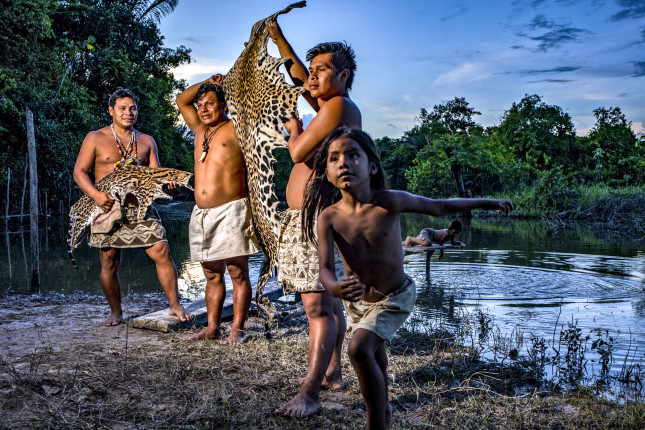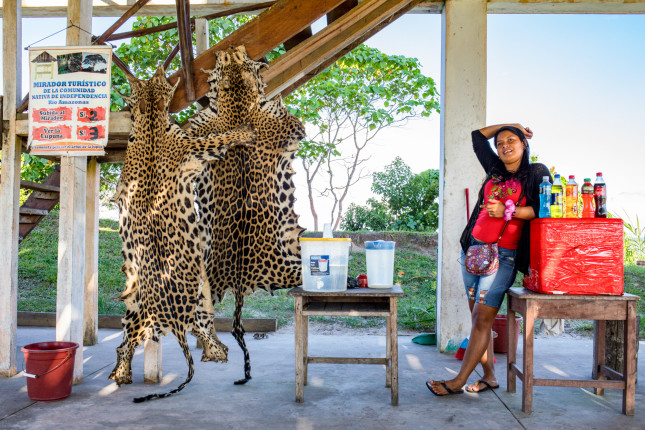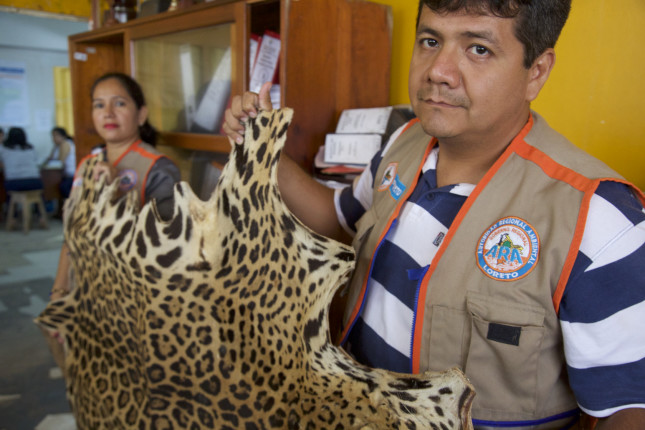-
Can the Growing Trans-Pacific Wildlife Trade Be Stopped?
March 3, 2023 By Sharon Guynup
Today’s celebration of World Wildlife Day is a perfect time to focus greater attention on the rapidly growing Latin America-to-Asia wildlife trade. It now has reached crisis proportions, with both illegal and legal shipments rising in tandem with China’s economic investment in the region.
Experts link this mushrooming trans-Pacific animal trade to large-scale development projects by Chinese companies. Over the past 15 years, two state-owned Chinese banks have loaned more than $140 billion for infrastructure, road, railway and mining projects in Latin America.
It is a pattern that the world has seen before. The nonprofit Wildlife Conservation Society warns that “similar conditions were present less than two decades ago in Africa prior to the Asian-driven declines in Africa’s megafauna that we see today.” As one of the world’s most biodiverse regions, Latin America has become an obvious next target.
Market Forces, Critical Habitats, and Crime
I first learned of this issue in 2017 when I traveled with a National Geographic team to Iquitos, a notorious illegal wildlife trade hub at the gateway to the Peruvian Amazon.
Our goal was to investigate reports of growing jaguar trafficking in Peru. We found pelts, taxidermied heads, and jewelry fashioned from jaguar teeth and skins in nearly every store and market we visited there. For the first time since the “American tiger” was given strict protection under a new international treaty in 1975, this supported a growing body of evidence that jaguars are now once again in the crosshairs.
Yet officers at the Loreto Regional Environmental Authority informed us that jaguar poaching was just one small part of a skyrocketing trade in rare animals. They said that even legally-traded species were being hunted at unsustainable levels.
Our discoveries on this trip prompted me to delve deeper. In a recent Wilson Center white paper, I reported that a vast array of wildlife is being pulled from Latin America’s land and seas: monkeys, sharks, ocelots, frogs, birds, snakes, lizards, aquarium fish, sloths, seahorses, totoaba, turtles and more. While some animals are sold locally, most are shipped halfway around the world—alive, dead or in parts—with China as a major destination.
The species sold there are consumed as delicacies (most notably sea cucumber and shark fin soup) or as ingredients in traditional Chinese medicines. They are also bought by pet owners and collectors and fashioned into clothing, jewelry, trinkets and high-end home décor.
These Chinese-backed development projects threaten Latin American wildlife in numerous ways. They threaten up to 24 percent of the world’s rare birds, mammals, reptiles and amphibians through poaching and ravaged habitat. An analysis published in Nature Ecology & Evolution estimated that through the Amazon and other previously inaccessible wilderness opens these wild lands to people and commercial activity.
A notable jump in organized crime in Latin America predated the spike in poaching there—just as it did before the African wildlife crisis that hit in the mid-2000s. With light penalties and rare prosecution of poaching or trafficking, many of Latin America’s criminal organizations have added eco-crime to their business portfolios. These groups often smuggle rare wildlife, fish or timber alongside narcotics, firearms and trafficked humans. Wildlife trafficking has become the world’s fourth largest criminal activity.

Biodiversity at Risk
Poaching has caused catastrophic declines to the Latin American wildlife and now poses the paramount threat. Yet it also threatens our own survival. Humans depend on the planet’s vast web of life––organisms that evolved in intertwined synchrony over millions of years––for food, water, a stable climate, medicine and income.
The most recent World Wildlife Crime report from the UN Office on Drugs and Crime emphasized that wildlife crime not only threatens biodiversity and the environment we depend on, but also endangers human health through illnesses that originate in animals. About 75 percent of new or emerging infectious diseases that have infected humans over the past three decades are zoonotic.
Interpol Secretary General Jürgen Stock recently explained why fighting eco-crime is also key to global security. “Timber and wildlife trafficking are not just conservation issues,” he observed. “Officers lose their lives every year, livelihoods are destroyed, diseases are spread, governments weakened and entire economies destroyed.”
Stock added that the huge financial gains offered by this activity “attract serious organized crime and terrorist militants who grease the wheels of crime with heavy doses of corruption.” The money generated by these crimes supports money laundering, human trafficking, and other illegal activities that affect people and the rule of law.
Taking Action
Heavily trafficked animals have disappeared from many parts of Asia and Africa over the past three decades. And though history is repeating itself in Latin America, earlier intervention and international cooperation could prevent the same level of devastation there.
Since our report published last fall, there have been landmark conservation agreements that offer hope that the worst outcomes for some Latin America species might possibly be averted. Many Latin American species—including sharks, turtles, frogs, and stingrays, as well as others—were granted stronger protection at the November meeting of the Parties to the Convention on International Trade in Endangered Species of Wild Fauna and Flora (CITES).
The 2023 celebration of World Wildlife Day also marks the 50th birthday of CITES. Signed in 1973, this treaty has been adopted by 183 nations and the European Union, and regulates international trade in nearly 40,000 imperiled species of animals and plants.
Latin American nations are already coordinating in a more organized way than Africa was able to achieve. In 2019, a coalition of 21 Latin American and Caribbean countries joined forces to sign the Lima Declaration—an agreement to enact stronger wildlife laws, close legal loopholes that benefit traffickers, implement better enforcement, improve criminal justice responses, and enact stricter penalties for offenses.
Some countries have expanded operations beyond busting poachers and middlemen traffickers and seizing shipments of dead animals. These governments are now targeting kingpins who mastermind the trade and charging wildlife traffickers with serious offences: money-laundering, corruption and fraud.
Interpol’s I-24/7 global law enforcement communication system and the International Consortium on Combating Wildlife Crime also are helping to forge critical regional coordination. But experts note that for Latin American nations to win this fight, it will require technical and financial assistance to better prevent, detect, and investigate wildlife crime.

Navigating Regional Challenges
Both Mexico and Peru provide examples of the ceaseless nature of these particular eco-crimes in the region and illustrate how challenging this fight truly is.
Illegal wildlife trafficking controlled by narco-traffickers is “rampant” and “out of control” according to a new study by the Center for Biological Diversity. Much of that trade happens online, with protected species sold openly on Facebook and TikTok under false profiles that make enforcement nearly impossible.
Peru adopted a 10-year strategy in 2017 to combat wildlife trafficking, In doing so, it became one of the region’s first nations to recognize eco-crime as organized crime and establish stiffer sentencing. But the ongoing political turmoil and widespread violence there (among the worst in decades) has caused officials to lose focus. How can Peru’s government agencies focus on protecting monkeys or jaguars under these circumstances? Peruvian Society for Environmental Law expert Patricia Torres said in an interview that “instability is preventing there from being a solid implementation policy for what we want to do on wildlife trafficking.”
In 2019, the World Bank Group estimated illegal logging, fishing and wildlife trade to be worth $1 to $2 trillion per year. But without an international legal framework, it’s impossible to effectively fight or prevent transnational wildlife trafficking that overlaps with drug, gun and human trafficking crimes. Many experts have echoed a clarion call requesting that the United Nations Convention against Transnational Organized Crime create a wildlife crime protocols with a framework for standardized laws and enforcement procedures.
The Wildlife Conservation Society’s Susan Lieberman is hopeful about these concerted efforts to control Latin American wildlife trafficking, especially because it’s happening much earlier in the game than it did in Africa. “If enforcement is increased and governments collaborate more with each other,” she said, “I believe we can stop this in time.”
Sharon Guynup is a Global Fellow with The Wilson Center’s Environmental Change and Security and China Environment Programs. She is also a National Geographic Explorer. Much of her work on environmental issues focuses on wildlife, ecosystems and the threats they face.
Sources: ABA Journal; CITES; Diálogo Chino; The Harvard Review; The Inter-American Dialogue; Interpol; IUCN; Nature Ecology & Evolution; Wildlife Conservation Society; World Bank
Photo Credit: Members of the Boras Communidad, a Peruvian Indigenous group, with a jaguar skin from a cat they’d poached, courtesy of Steve Winter/National Geographic.
 A Publication of the Stimson Center.
A Publication of the Stimson Center.





